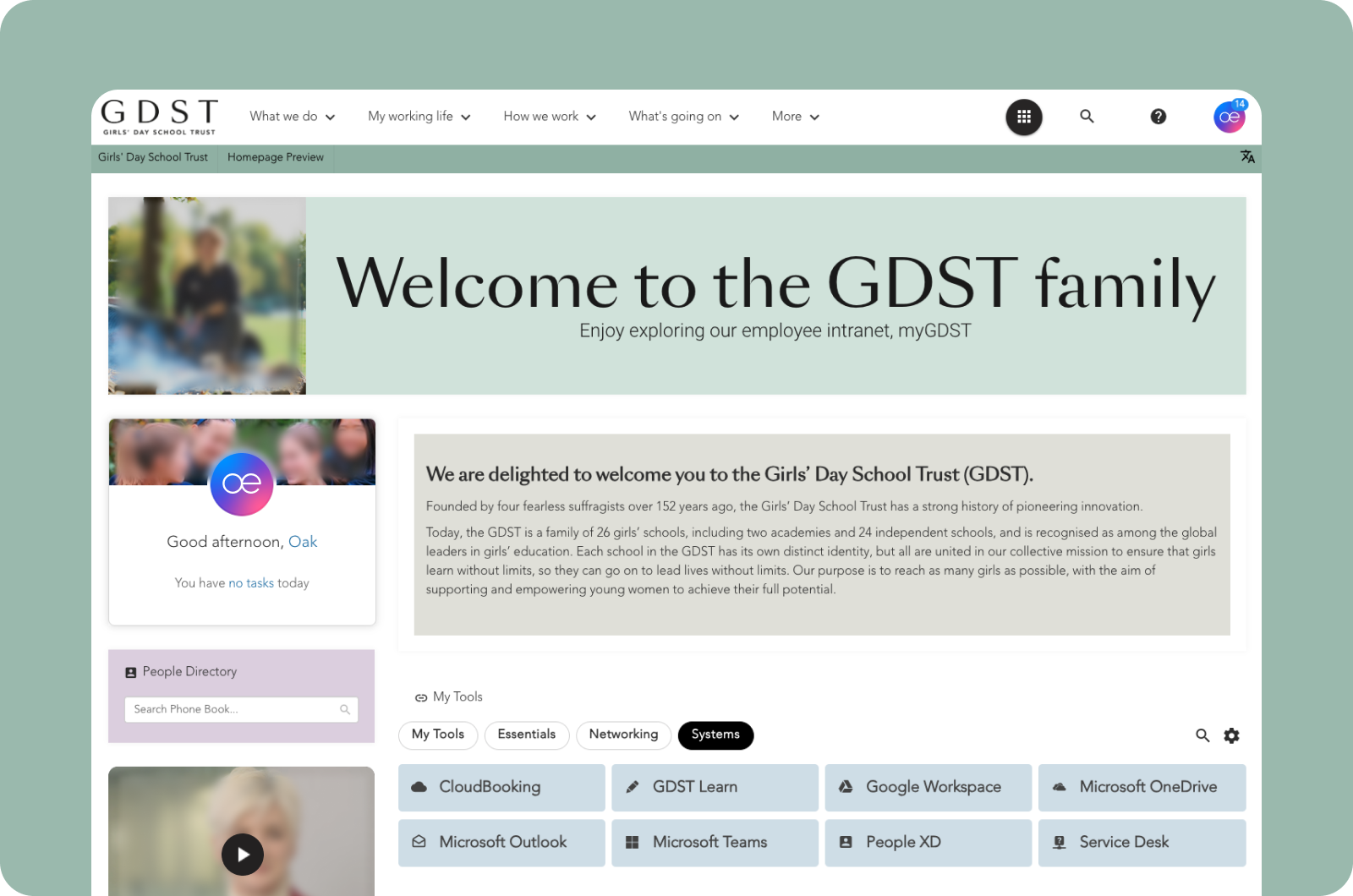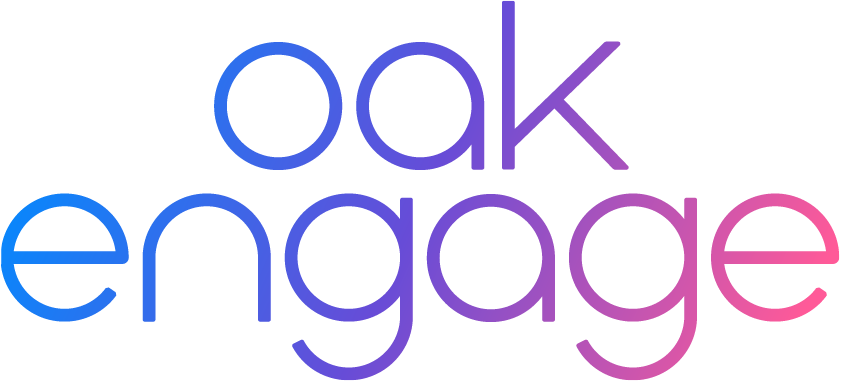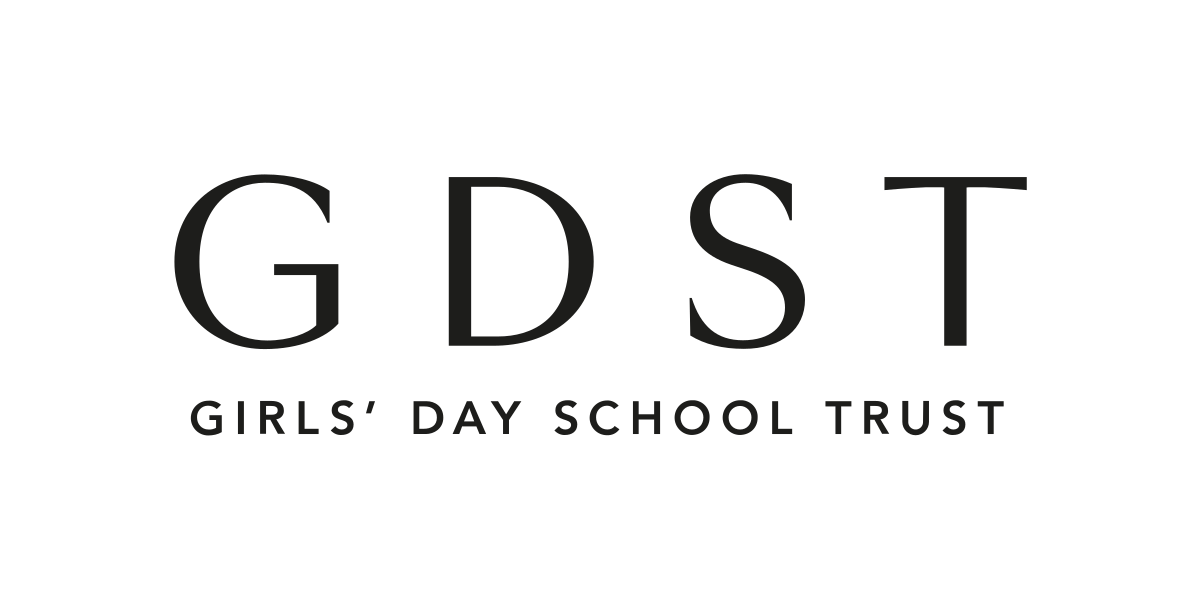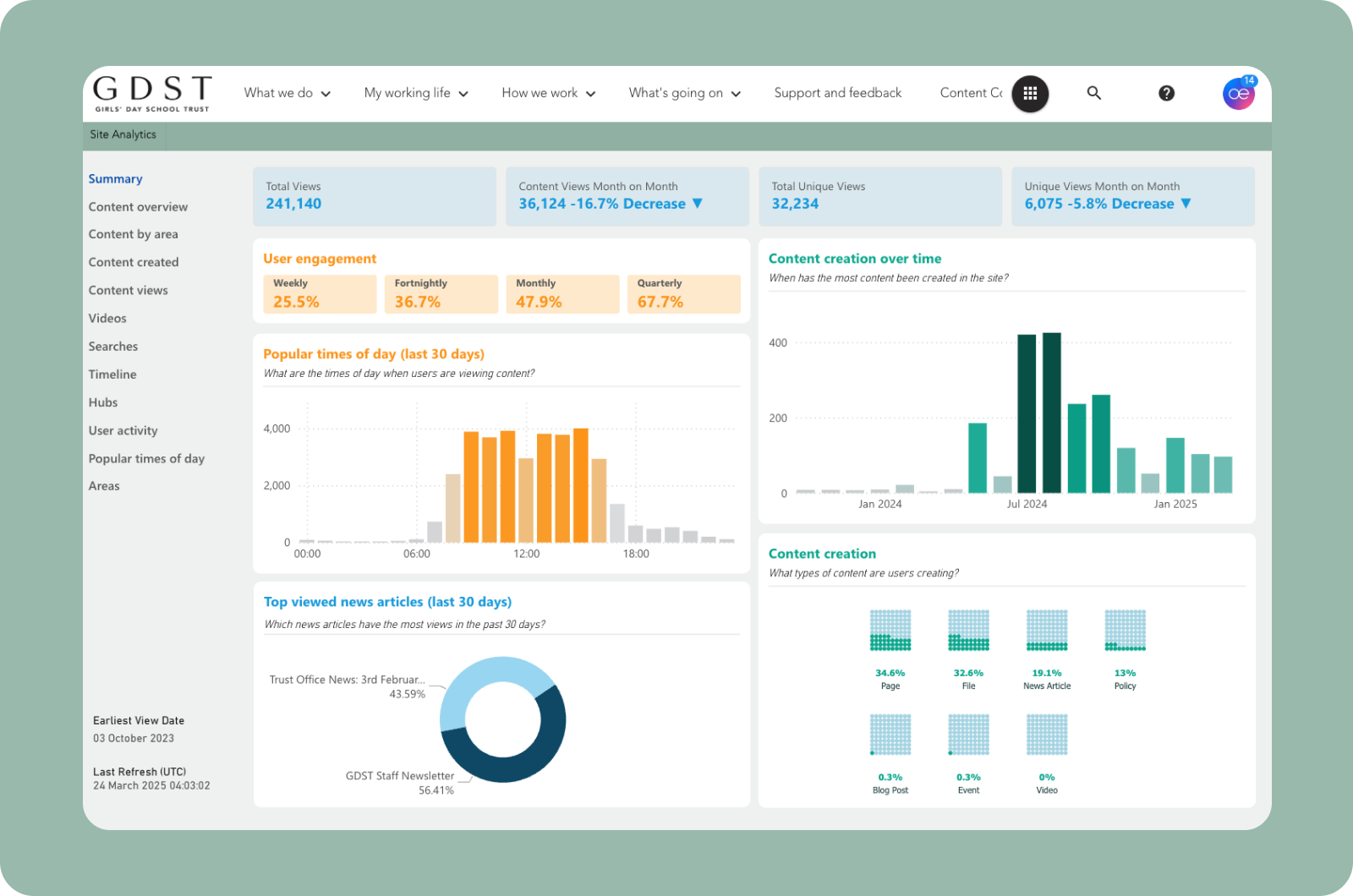Lessons in employee engagement from the Girls’ Day School Trust
The Girls’ Day School Trust (GDST) is the UK’s leading network of girls’ schools educating 19,000 girls each year. Historically, the GDST used a SharePoint site for document storage, but with such a large and growing network of schools, they needed a modern platform as a ‘front door’ to GDST to drive employee engagement, connection and collaboration.
Industry: Education | No. of users: 5,000 | Area: UK
Results with Oak Engage
Improvements in people data standardisation
Seamless onboarding of entire new school using Oak platform
The Challenge
The Girls’ Day School Trust had limited channels to communicate to staff in all positions across the trust. Relying on a termly newsletter, a termly email from the Chief Executive and intermittent emails on operations. Communications were one-sided with little scope to measure readership and impact. While they did have a SharePoint site, it was solely for document storage, offering no opportunities for colleagues across the trust to connect and engage.
Prior to this project, internal communications had not been prioritised across the organisation, but in the aftermath of the pandemic and with ongoing organisational change projects, the value of investing in their internal communications strategy was clearer than ever.
With 26 schools in the trust, each had varying methods of communicating with their staff.
The Solution
myGDST
Limited in comms channels and eager to bring all employees within the Trust together, they wanted their new intranet to underpin the GDST brand and mission, helping staff feel that they share a common purpose, with the resources needed to make their jobs easier and more rewarding.
"We wanted to revolutionise the way we communicated. We were selling the dream to the wider organisation, of when we create content, it doesn’t have to be one-size-fits-all for external and internal audiences. We didn’t want everything from SharePoint to be copied and pasted onto the new intranet. We wanted to transform the digital experience completely.
Nicola Borrow, Head of Communications at the Girls’ Day School Trust.

Research
The team at GDST ensured that their audiences were involved in the planning process. After all, they would be the ones using it, so it had to suit their requirements. Once they had their whole list of requirements, they were able to prioritise what they would want from phase one, phase two and so on.
“We ran a workshop with staff from different schools, levels and departments including the Trust office. We asked them, based on their experience in other organisations versus what we have, ‘what is it that you think we need from an intranet?’ Once we had gathered these insights and outlined our requirements, we participated in demos from two shortlisted suppliers. It was very close, but professionalism of the final demo versus the other contender took Oak over the line. The friendliness and support from the team came across in presentations, and a negotiation on a multi-year deal took us into our partnership with Oak.”
Milly D'Costa, Project Manager at the Girls' Day School Trust
The pilot
Once the intranet was almost ready to go, GDST ran a pilot. This included their central office staff, one whole school, a focus group from another and key colleagues and specialists across the organisation who would be contributing to and using the platform on a regular basis.
“We wanted to get feedback from those on the ground using it every day. Once it was live with as much content on there as possible, we ran the pilot for about four weeks and encouraged as much feedback as possible, from whether links were working and colour schemes and design looked right, to suggestions on adding new tools to their tools applet. Other feedback included highlighting specific areas of the site more, adding new areas and building new pages.”
Sophie Hickey, Internal Communications Manager at the Girls’ Day School Trust
Throughout these four weeks, they gathered a lot of valuable feedback which led to final tweaks to the site as part of the pilot phase, before the official launch in November of 2024.
The Launch
Following the pilot, the project team ran internal roadshows to explain the importance of engaging with staff rather than just churning out information and expecting change to happen.
They ran a ‘soft launch’ with an educational campaign around practical things that users can do on the site, featuring top tips, how to favourite content, personalise your tools app and where to find information on the new platform, before deactivating the old intranet. Now ‘myGDST’ launches for all employees when they open up their internet browser, so it’s one less click away.
Nicola explained: “By doing a soft launch, we’ve been able to test things that we know we will use later. Community Hubs were never a part of phase one, but people actively welcomed the additional functions of myGDST as they are more digitally advanced than what we had previously and easily enabled staff to connect across our schools.”

Supporting a new school
In February 2025, Redmaids’ High School in Bristol joined the GDST. Their perfectly timed launch of ‘myGDST’ has provided a single and engaging place where the school’s 200 staff can easily access important information about GDST.
What’s more, the new school’s introduction to the trust has been gradual to avoid information overload, by being able to tailor the content delivered to these users, which wasn’t possible on their old platform.
Nicola said: “We have been able to personalise the homepage for our new school’s staff as well as some of the key information areas of the site. This has meant the new staff feel included by having access to the whole site but have additional explanations to enable a smooth introduction to the organisation. With their own dedicated space, we have been able to promote particular updates and areas and they can actively explore and engage with other content at their leisure.“
As part of the campaign to welcome the new school, myGDST has empowered the executive leadership team to take part in content including a video to welcome the new school.
Nicola continued: “This is the first school in 20 years that's joined GDST and without myGDST there would not have been an opportunity to communicate like this. myGDST has given us a central place where they can go for all the information, and Oak has made the whole transition so easy. For the staff at Redmaids’ High, literally on day one they’ve got their account, they've visited myGDST and they've got all their information that they need at their fingertips.”

The impact
Culture shift
Each school is unique and prior to launching myGDST, it was very much a case of focusing on your own school’s communications first, and GDST second. Now that the new platform provides a space where all the benefits of working within a trust can be realised, sharing best practice, collaboration opportunities and easy access to GDST systems, tools and policies, there is real value for every staff member when they access it.
Nicola commented: “The fact that we can promote the benefits and opportunities that are available from being in a family of schools rather than being a standalone school, is game changing. I think it’s going to feel like it's school first, then GDST, but the more we push the benefits and the opportunities that are available by visiting the schools and hosting training sessions, we can tailor the learning around the intranet to their preferences that will further drive engagement over time.”
Unified source of truth
myGDST provides a single source of truth and a one-stop shop for colleagues to access everything they need to do their job well. i.e. providing links to other platforms and tools.
Supporting strategic operations
The intranet has been called a ‘game changer’ in the way that GDST are now able to work and connect across the organisation. This project has provided a tangible example of how something like a school joining the organisation could be supported within the trust’s existing infrastructure.
Modern content management
Following the transition from SharePoint, GDST made the strategic decision to move policies from PDFs and Word Documents that could be downloaded and stored locally, to on-page content, allowing for greater version control. Permission-based access to these resources ensures that only certain people can edit or view them, based on seniority or job type, offering peace of mind for users that the policies are the latest version.
Progression opportunities
myGDST has enabled the Trust to create greater transparency in their internal recruitment processes and jobs within the Trust are visible to all employees. In time there is potential to use myGDST for onboarding of new staff.
Time efficiencies
Previously, trying to find a list of people in specific job roles would have been a long and manual HR job. Now, with the People Directory, they can do it in seconds, saving time and frustrations for users.
On ease and speed of use, Nicola commented: “The people directory is so helpful, and it’s always my top tip when I talk about myGDST. We now have the ability to type ‘history teacher’ and if you don't know the school or history teacher, you get the list of history teachers. We would never have been able to search in that way from the systems that we had before.”
The search functionality has also been truly transformative in streamlining information access. While the navigation on the site is clear and well structured, time-poor colleagues can rely on the search tool to find resources in seconds.
Nicola continued: “I love the search – it's brilliant! I enter a couple of words and the right information pops up! And if it doesn't, then I can quickly fix it by finding the right page and editing the tag. I get very lazy navigating around the site now. “
Efficiencies with built-in newsletters
Being able to send automatically generated newsletters from within the Oak platform has saved countless hours and manual administration for the internal comms team.
Sophie explained: ”I used to send out all our staff newsletters and CEO comms with MailChimp. I had to deal with a lot of manual data from another colleague who had to provide it for me. I had to manipulate that data which opens up room for user error, plus it's very time consuming and the newsletters in MailChimp weren't looking great either. Now, we can send out all our internal comms newsletters and bulletins from Oak, and they look good. I have heard praise echoed across other teams who previously used external platforms but are now using Oak too. We've got the analytics, we've got an easy archive of all the past comms that have been sent. That is probably the game changer for me in my role.”
Levelling up from SharePoint
Beyond document storage, Oak’s content library has provided more than SharePoint could offer and has really helped with version control.
Milly added: “I think the document library is a vast improvement from our SharePoint site, not just a search function, but also the associated results, the other documents and everything that's related to that particular policy. It's so much better than what we had before and I’ve definitely found that useful.”
On the differences between SharePoint and Oak, Nicola said: “Trying to navigate policies on SharePoint was difficult as they were stored on multiple sites. MyGDST (Oak) has a set process to create and store policies, we have introduced that policies cannot be downloaded, which is taking some education as to why this is important. But it works, and it’s been a really robust system for us to make sure that everyone's following the same policy.”
The power of analytics
Prior to the launch of myGDST, the internal comms team had no way to monitor which information was resonating and whether people had seen their communications at all. This has been revolutionised with Oak’s intelligent analytics and reporting capabilities.
On measurement and reporting, Nicola shared: “What's really good is the analytics behind Oak. We can see which schools are really engaging and which aren't. Then we can work with the schools that don't have such great engagement and find out why. There could be a number of reasons as to why engagement is low, for example, it could be as simple as it's not been navigated in the right way or they don't understand where to go for certain information or a particular policy.”
Creating a FOMO mentality
Even in just three months since launch, it is clear that there is a greater sense of belonging and knowledge about the organisation building.
In the next phase of the project, as myGDST continues to grow as a cultural hub for all employees to utilise, they plan to deliver more inspiring engaging content and encourage employees to do the same in order to create a digital atmosphere where staff look forward to checking in for updates.
Nicola concluded with: “Everyone we've dealt with at Oak has been so lovely to work with. Graham in particular, building our intranet, he was very patient with us, but it was worth every hour spent in preparation for the results that we have had.”
Ready to get started?
If you like what you see, we offer a free and personalised demo service, showcasing our intuitive and easy-to-use platform. Tailored to meet your specific needs.



